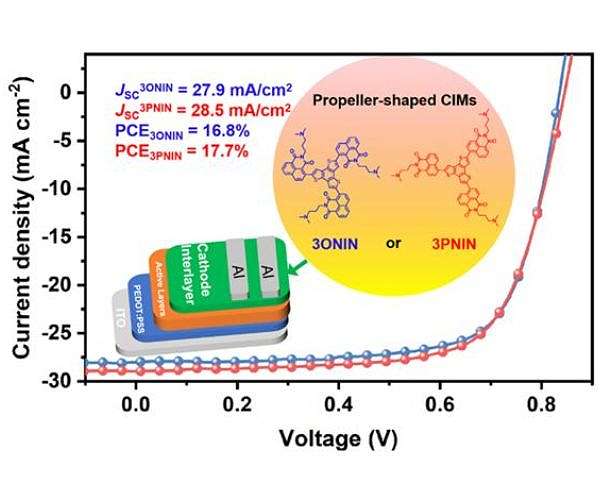
Researchers unveil molecules that could turbocharge organic solar cells
by Riko Seibo
Tsinghua, Japan (SPX) Feb 28, 2024
In a groundbreaking study published in Nano Research on February 6, a team of researchers has unveiled a revolutionary molecule, 3PNIN, designed like a propeller, which promises to significantly enhance the efficiency of organic solar cells (OSCs). This advancement could mark a pivotal shift in the renewable energy sector, particularly in the development and application of OSCs.
OSCs have been celebrated for their lightweight, flexible, and potentially cost-effective production compared to traditional silicon-based solar cells. Despite their advantages, OSCs have faced challenges, especially in the realm of cathode interfacial materials (CIMs). CIMs are crucial for efficient charge transfer between the cathode and the active layer in OSCs, directly influencing the power conversion efficiency (PCE) of the cells. Until now, the evolution of CIMs has lagged, hindering the full potential of OSC advancements.
The study focuses on the introduction of two propeller-shaped isomers, 3PNIN and 3ONIN, which share the same molecular formula but differ in the arrangement of their end-capped groups. This structural variation allows for distinct intermolecular interactions, significantly impacting the functionality of CIMs and, consequently, the photovoltaic performance of OSCs.
Professor Minghua Huang, a leading author of the study, highlighted the importance of OSCs in the contemporary renewable energy landscape. According to Huang, “OSCs have ascended to prominence, characterized by their ethereal architecture, semi-transparency, cost-effective production, and scalable printed assembly, heralding a new era in powering flexible wearable technologies.” The advent of 3PNIN and 3ONIN represents a significant leap forward in addressing the longstanding efficiency challenges of OSCs.
Testing revealed that the two compounds exert profoundly different effects on the functionality of CIMs due to their configurations. 3PNIN, with its more planar molecular structure, allows its end-capped groups to lie flatter compared to 3ONIN, leading to enhanced electron mobility and conductivity. This structural advantage results in OSC devices treated with 3PNIN achieving a PCE of 17.73%, surpassing the 16.82% achieved with 3ONIN-treated devices.
The implications of this research extend beyond the immediate enhancements in OSC efficiency. 3PNIN not only promises to create thermally stable devices but also opens the door to further refinements in OSC technology, potentially increasing the accessibility and efficiency of renewable energy sources. Such advancements could significantly impact the broader landscape of renewable energy and organic electronics.
The collaborative effort behind this research involved Hao Liu, Jilei Jiang, Shuixing Dai, Xianbiao Hou, and Minghua Huang from the School of Materials Science and Engineering at the Ocean University of China; Liangmin Yu from the Open Studio for Marine Corrosion and Protection at the Pilot National Laboratory for Marine Science and Technology; Xu Zhang and Ke Gao from the Science Center for Material Creation and Energy Conversion at the Institute of Frontier and Interdisciplinary Science at Shandong University; and Heqing Jiang from the Qingdao Key Laboratory of Functional Membrane Material and Membrane Technology at the Chinese Academy of Sciences.
This study not only provides a promising pathway to enhance the efficiency of OSCs but also underscores the critical role of molecular structure in advancing renewable energy technologies.
Research Report:Propeller-shaped NI isomers of cathode interfacial material for efficient organic solar cells
Related Links
Tsinghua University
All About Solar Energy at SolarDaily.com
- SEO Powered Content & PR Distribution. Get Amplified Today.
- PlatoData.Network Vertical Generative Ai. Empower Yourself. Access Here.
- PlatoAiStream. Web3 Intelligence. Knowledge Amplified. Access Here.
- PlatoESG. Carbon, CleanTech, Energy, Environment, Solar, Waste Management. Access Here.
- PlatoHealth. Biotech and Clinical Trials Intelligence. Access Here.
- Source: https://www.solardaily.com/reports/Researchers_unveil_molecules_that_could_turbocharge_organic_solar_cells_999.html



